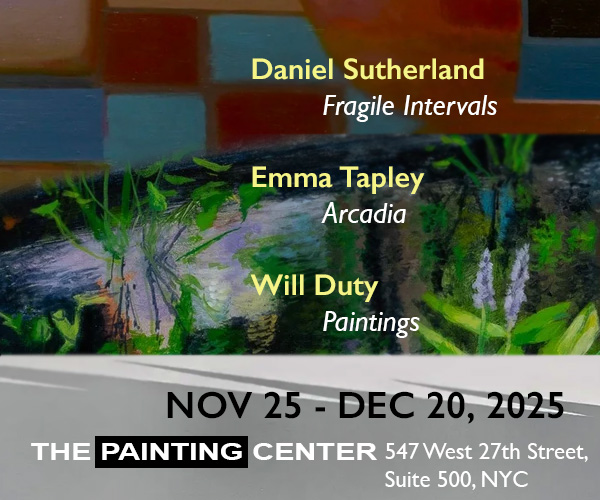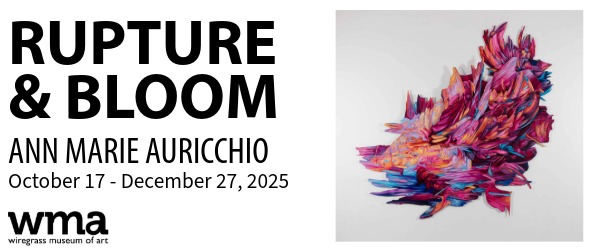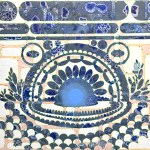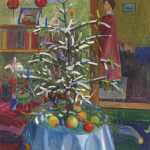
Something there badly not wrong
— Samuel Beckett, Worstward Ho
Contributed by David Humphrey / The spinning rainbow symbol interrupts our screen time. Buffered and helpless, we pause with the device to wait, perhaps to sink back into our thoughts or to drift into another task. That rainbow, called by some “the wheel of death,” is now on my screen as I write this sentence, asking for patience while an aging browser opens an email. Austin Lee, in his painting Croma (2018), has imagined this rainbow disk as an agent, a smiley-faced personage who looks back at us with wobbly cheer and unfocused sociability. The glowing grey-scale background of Croma has the radiantly blurred atmosphere of a malfunctioning screen and highlights the crisp contours of the rainbow-face with its ambiguously unsolicited message. The eyes are two scribbles and the smile meanders erratically from the conventional U-shape. Croma is big, 6 x6 feet, and its centered face functions as an emoji addressed to us. Does Croma ask for something? Or does it warn? Promise? Confess? Blame? We, its passing receivers, interpret it according to our ways. But Lee’s jaunty blankness is a friendly space to project into.

His paintings have close ties to imaging software. Computer tablets, for a person who makes drawings, have a warm capacity for intimacy and directness, in addition to the ability to undo, redo, composite or change any picture variable. The images can be outputted as prints, sculpture or projections, distributed online on any platform. But Lee is committed to transforming his images into paintings. He has metabolized virtual imaging before crafting its disembodied qualities into emphatically made objects. Making, for him, is a kind of performance that conjures bodies caught between states, including his own. Airbrushed gestures dance on colored surfaces like graffiti tags on buildings, but they also describe features of a face expressing surprise, disgust, sadness, anger, fear or happiness. People kiss and hug; pets are caressed and boxers fight. In BBB, a person is being tender with a horse. In OOO, the wrestlers merge into a new organism that struggles with itself. LLL is a pink field with two hairdos, four eyes, two noses and two mouths in a kind of daft sisterhood.

In JJJ and FFF, the character in the painting is responding to its condition of being painted. The dancing purple animal in JJJ seems disconcerted by the oppressive weight of a brush pressing onto its head with a load of yellow paint. The smiling person in FFF has a painter’s palette for a body and seems to enjoy being stroked into existence. FFF poses Donna Harraway’s question in her Cyborg Manifesto: “Who makes and who is made?” Cyborgs for her, like Lee’s paintings, are a fusion of imagination and material reality. His work plays with inherited notions about the boundaries between the living and non-living, the virtual and material, the mental and the physical. It makes sense that Lee’s characters are frequently in the throes of what looks like rapture or ecstasy. Their intense joy takes them out of themselves, but maybe this self and this joy wasn’t really theirs in the first place. But whose is it? In Rise (2018), a radiantly lumpy figure raises arms and face to a descending bird-lump as if this inter-species encounter bore the promise of revelation. The revelation, though, might be that they are both creatures, conjured beings, in a comically animated netherworld. The smiling blue girl in Earth Gifts (2019) is all hearts, flowers and rainbows bathed in magenta warmth. In QQQ, a naked and smiling human with long hair surrenders to a flowering meadow. The undifferentiated body sinks in as the meadow licks envelopingly up. The oversized bliss of these paintings, with their three or four bold colors, is somehow a little fucked-up. But locating that wrongness is a challenge: is the problem in the picture or is it in us? Does it originate in the artist or from the world? This could account for the hint of sadness (that I feel anyway) tugging at Lee’s playfulness. It might be part of an understanding that wishes are already infused with disappointment.

Flowers grow to be looked at and to make people happy. Austin Lee sprinkles features across a face the way he arrays flowers on a canvas, seemingly flung. Everything lands in its position as though it could easily, by whimsy or a drift of attention, be somewhere else. Like Like (2018) pictures a strange Valentine’s day in which a flock of eyes cuts through a flock of hearts. The couple in NNN are not doing well. The smiling driver seems unaware of the watchfully anxious passenger in the tight space of their gooey, rain-soaked car. A pair of dancers join hands with shared mirth in AAA, but their hands seem like subdividing blobs. The two are distinct, maybe of different species, but their union is a happy choice, heedless of anyone’s judgment that they might be mismatched. They smile with fused hands and separate identities: a blue shirt and a red shirt.
Lee’s work tells a story about touch that is both detached and emotionally saturated. The marks on his canvases are haunted by a past thoroughly rehearsed in different mediums, but delivered with the tossed-off spontaneity of a well-timed quip. Airbrush responds to the slightest hand movement but also blurs that movement in a haze of atomized paint. Lee sprays physicalized pixels, analogous to what he did on the screen but with the wobbliness of one’s first experience with a computer mouse. Left, right, up and down don’t immediately correlate with the screen cursor. But the haptic/perceptual turbulence quickly goes away with a little practice and we become acclimated screen inhabitants.
Lee has become very skilled with the drawing tablet, a master of awkward simplicity. His stories of contact — stroking, brushing, hugs and kisses — develop alongside process narratives; this sprayed patch or scribble precedes that one, followed by another on top of another. His forms do not always occupy their positions according to the spacial logics of foreground and background, over and under. The shapes are a bit unruly as they nudge and jostle each other, pushing forward or slip sideways but never giving up their signifying role in the simplified picture of a person, horse, flower or pooch. Daubed goo floats over atmospheric effects and legibly modeled form. Drop shadows create the illusion of painted shapes lifting off the canvas’s surface while broken or interrupted edges collapse the illusion. The elements have independent lives variously cooperating in the picture fiction. In WWW, four hands (or are they feet?) stroke a smiling blue pet. The animal is all head, tapering at the top and chin into a bulbous lozenge. I like thinking of this painting’s jolly blue schmoo-pet as a stand-in for the living painting, accessorized with sense organs and other defining characteristics. Making, for Lee, is a version of caressing; objects are petted or stroked into existence.

Lee’s color, like his forms, performs as an independent agent, a force with free-floating associative capacities. Red and blue bang into each other, green drags the landscape into the picture, pink sings about artifice in a duet with magenta’s melody of technology. Resonance, assonance and dissonance are musical metaphors for how colors can combine to create mood or feelings. But color is semiotically squirrely and Lee sets the squirrels loose into a world of gradient rainbows and blurred Crayola landscapes. But can color disagree with content? Or pretend to agree? Yes! That’s what it is to have agency. Hue and memory flood each other, fusing and redividing as a dance.
Greeting cards subcontract the expression of feelings for a small price; coloring books enforce an ideology of conformity. Illustration and public-service graphics deliver information simply and directly. These genres have genealogical connections to Lee’s work but in every case something goes a little off. The simple content drains away, becomes blank, only to reemerge with the skewed shadow of a generic message or affect. We can call it a mimetic disorder, and at Lee’s large scale, that disorder is funny and moving. His works muscularize vacuity in the form of phantom bodies sprinkled with a variety of identifying details. But these marks, like human identities, are used as contingent adornments in a utopian vision of fluidity and freedom.
Beckett’s phrase “Something there badly not wrong” suggests some of the oscillating impressions Lee’s work can make. Presences emphatically conjured also dematerialize and shift — as though the image, in its suspended virtuality, were a snapshot. And, like a snapshot, the pictured moment implies a before and an after. Beckett’s text continues “Not that as it is it is not bad.”The two sentences have a weird math that flavors Beckett’s assertion. In Lee’s case, the assertion is that matter is euphoric and the artist is an animal-loving soft machine navigating a habitat of desires with and for oddly differentiated others.
About the author: David Humphrey is a New York artist who has shown nationally and internationally. His solo show, “Arms of the Law,” opens at Fredericks & Freiser Gallery, NY, on November 12. He has received a Guggenheim Fellowship and the Rome Prize among other awards. An anthology of his art writing, Blind Handshake, was published by Periscope Publishing in 2010. He teaches in the MFA program at Columbia.
Note: This essay was originally published in a Kaleidoscope monograph comprising Austin Lee’s 2012-2019 paintings.






















